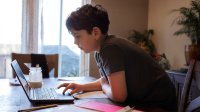How to Help Students Improve Executive Functioning During Hybrid Learning
Students who struggle with executive functioning may find hybrid learning difficult, but there are simple ways to make it easier.
Your content has been saved!
Go to My Saved Content.Executive functioning is a set of skills that comprise working memory, organization, flexible thinking, and self-control. We use executive functioning skills daily to learn, work, organize, manage schedules, and complete tasks. Many students have executive functioning challenges that can make it extremely difficult to focus, follow directions, organize learning spaces, complete tasks, and control emotions. These challenges can negatively impact learning and school experiences.
For some students, executive functioning challenges are present in school every day, even when there is a consistent and predictable routine. Now imagine the challenges that students with executive functioning deficits encounter when navigating the ever-changing schedule of hybrid learning.
The thoughts and frustrations can pile on with inconsistent days, variable schedules, and flexible routines, possibly leading to withdrawal, maladaptive behaviors, and an increased risk of school failure. However, there are solutions and accommodations to decrease undesired behaviors and disorganized thoughts associated with executive functioning challenges in the hybrid learning model.
Planning and Prioritizing
Executive functioning includes planning and prioritizing learning. Students need to recognize the essential tasks to complete and create a plan for carrying out the tasks. Hybrid learning can cause important tasks to get overlooked, especially when teachers assign multiple tasks, the schedules are inconsistent, assignments extend over multiple days, and the location of learning can vary.
Solution 1: Schedules and calendars.Teachers and students can work together to create a calendar. Within the calendar, have due dates, daily home/school schedules, and times and links to virtual meetings. The key is to share only one day at a time, so that you don’t overwhelm the students with a monthlong trajectory of assignments. Keep it direct. All information (links and assignments) should be available in one easy-to-access spot.
Solution 2: Checkbox lists. To prioritize essential tasks, have a list of daily tasks to complete with checkboxes. Prioritize the list, so that the most important assignments are completed first. Using a checkbox list gives students a sense of direction and accomplishment as they work through the day’s essential assignments. Diane Harrises, an educational consultant from Manchester, New Hampshire, suggests a midday check-in for some learners, especially for those who may become frustrated if the visual of assignments and tasks listed for the day is overwhelming to them. Checklists are valuable if your student is learning from home and you don’t have consistent access to check in with them to ensure that they are on task.
Organizing and Tracking Belongings
Students are responsible for bringing all school materials to and from school each day within the hybrid model. The transport includes assignments, belongings, and curriculum learning materials, such as manipulatives and other accommodations. Knowing what to bring to and from home requires organization, planning, working memory skills, and the ability to track belongings. Unfortunately, that’s not easy for students with executive functioning challenges.
Solution 1: Color-coded material. Color-code supplies so that it’s easy to track the same subject material. For example, math binders, pencil cases, and folders should all be the same color. Additionally, request that students have only one color in their working space, whether working in school or at home. Keep all other materials away from the working space until the task is complete.
Solution 2: Home/school supplies. Make a supply caddy to keep at home and a supply caddy for school, alleviating the stress of forgetting tools and daily supplies. The caddy can store curriculum learning materials, manipulatives, and learning tools, and it ensures availability and access in both places to alleviate forgetting supplies. Additionally, if a student has a 504 or an individualized education program (IEP), keep a binder or box of labeled accommodations at home and a binder or box of accommodations at school.
Impulse and Emotion Control
Executive functioning involves planning, prioritizing, utilizing working memory, organizing, and cognitive flexibility. As one might imagine, impulse control can become quite daunting when it’s impossible to regulate the changing environment, especially with the hybrid learning model’s fluctuating schedules and routines. Frustration can lead to emotional and impulsive responses.
Solution 1: Mindful breathing. Often, when students are stressed, overwhelmed, or anxious, breathing can be shallow. When students take control of their breathing, stress can be more manageable. To promote calm bodies and minds, have students practice mindful breathing techniques in school.
Stephanie Letourneau, an inclusion teacher and mindfulness coach from Methuen, Massachusetts, suggests that students close their eyes (optional) and take deep breaths. Inhale through the nose for three seconds and exhale out the mouth for three seconds. Students place a hand on their stomach and a hand on their chest and can feel the rise and fall of each breath. Younger students can visualize blowing extra-large bubbles. She recommends practicing as a whole group and making mindful breathing a habit and a routine to be incorporated during both in-person and remote learning days. With consistency, students may begin to use the technique on their own to control emotions and impulses.
Solution 2: Brain breaks. Schedule time during the day for brain breaks and exercise. Bethany Fleming, an associate certified executive functioning coach in Windham, New Hampshire, suggests frequent physical movement breaks, which allow students to reset to regulate behavior, calm emotions, and control impulses. These breaks provide the students with an important opportunity to stimulate their sensory needs.
Additionally, Fleming emphasizes the importance of developing a relationship with students to learn what works for them: “What works for one student may not work for another. Relationships are important!”
When students are back in person full-time, all of the above solutions can apply to the classroom and after-school home learning.
